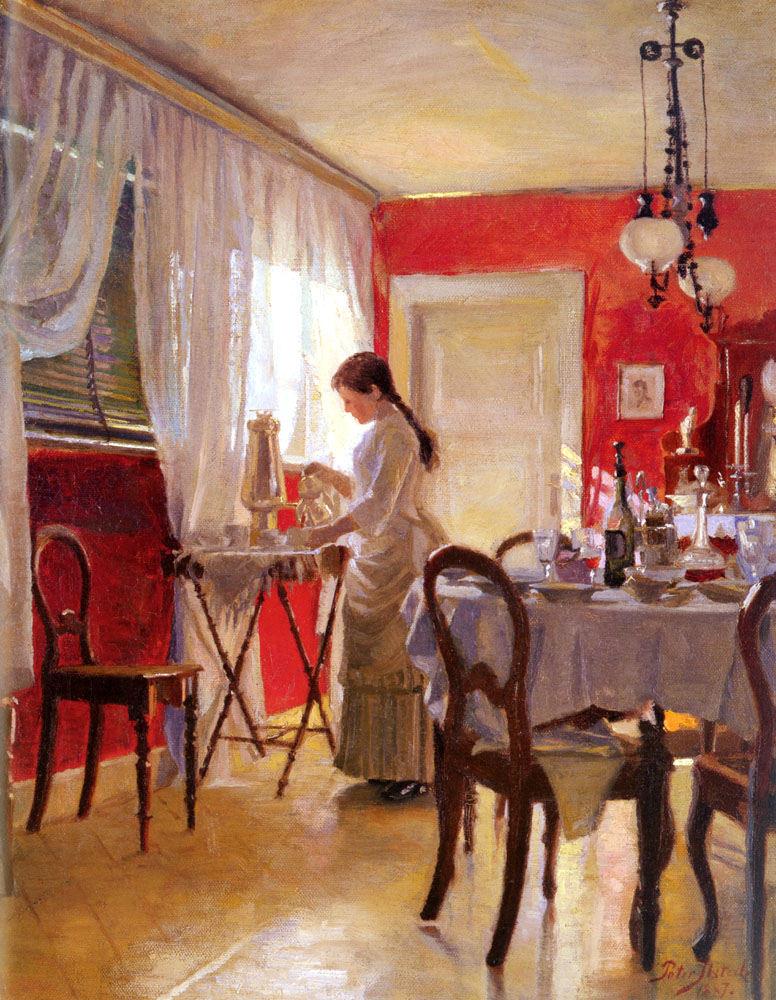The Industrial Revolution changed the world in many ways. It brought capitalism and consumerism into being, changing the world’s outlook on wealth creation. It revolutionized technology, allowing the innovation of mass production to expand exponentially. Jobs in factories shifted labor from farming to factories. With this came the migration of people from countrysides into cities as the economy shifted from an agrarian society into an industrialized society. This shift altered the social structure of the family. Beginning in the early nineteenth century, as the effects of the Industrial Revolution began to settle, a pattern became visible. With the rise of industrial labor, men transformed their function from director of work to provider of income, developing their role in the public sphere as laborers and professionals. Meanwhile, women took on the role of educating the children and keeping the home in order, forming the private sphere within the household.1
Historians argue over how we should understand these separate spheres. Some argue that working-class women had to participate in the public sphere out of necessity for earning a living, and therefore they were denied the choice of participating in the cult of domesticity.2 They argue that although these women’s position in society was marginal, they created an identity for themselves in the public sphere.3 While these historians claim that participation in the cult of domesticity was restricted to middle-class women, I argue that working-class women, when they had the choice, often chose to work in the private sphere, thereby choosing to participate in the cult of domesticity to the best of their abilities.

As the Industrial Revolution changed the mold of society, the public sector and the private home became two isolated and separate worlds. The private sphere of influence that women were associated with in the nineteenth century refers to the realm in which a woman’s role was as the head of the domestic household. In contrast, men participated in the public sphere, which included the worlds of labor, politics, and association.4 In her role in the private sphere, a woman determined the social reproduction aspect of the family, as opposed to the economic production. Social reproduction is defined by feminists as the labor involved in the maintenance of a lifestyle as well as producing the next generation.5 This work goes beyond bearing children, including activities such as making food, clothing, and shelter immediately available; teaching and caring for children; caring for the elderly; and providing a good moral example within her home.6 From an early age, girls’ education centered around making good wives and mothers with programs that guaranteed gentility and femininity. By participating in such activities, women helped to form the organization of society through their families. While the class of their families contributed to the flexibility of their appearance in the public sphere, there is a clear distinction between public and private worlds.
The newly formed middle class of the nineteenth century is the most overwhelming indication of the separation of spheres. With industrialization on the rise, clear gender roles emerged as the social structure of the family changed.7 Whereas in the working class both women and men contributed to the family income, in middle-class families the men worked for wages while their wives stayed home to manage the household.8 This gave women of the middle class little opportunity to participate in the public sphere. A clear indicator of middle-class status was the ability to keep any number of servants. Most families had only one servant.9 Nevertheless, it was the women of the household that directed their work in their homes. This was the contribution they made to their household. The occupation of homemaker, though valuable to the family, cemented their lives in the private sphere. Mothers were expected to provide for the education of their children. It was because of this ideology that middle-class women were able to be educated in math, literature, history, and foreign language, and to teach their children in turn.10 As daughters grew up, the limited education they received was the basis for wives and mothers to properly fulfill their roles, teaching their children as the cycle of domesticity repeated itself.

Due to their economic need to work, working-class women had more of an opportunity to be in the public sphere. In order to survive, these women, as laborers, interacted with employers, landlords, police, and other public institutions such as schools.11 This blurred the line between the private and public spheres. It was for this reason that working-class women were seen as hostile and aggressive. Although they did have interactions in the public sphere, this conflicted with their assigned role as caretakers. In order to do what was necessary to provide for their families, they were perceived as risking their moral virtue by entering the public sphere. With this morality at stake, it was easy for society to question these women’s ability to care for a household when the private and public spheres were viewed as being so isolated from each other. Thus, being employed in a factory, or another public institution was viewed as unfavorable to working-class families seeking jobs for their daughters. These daughters were to grow to become the wives and mothers of the next generation, so they needed to be viewed with the capability to support domesticity. Therefore, when women had the choice, these young women often chose to be employed as a servant, which was a less humiliating alternative to factory work.12
These young, working-class women helped their families by earning income while remaining in the private sphere. Their class status remained distinctly working class, as it was the distinction to hire a servant in the first place that separated the middle class from the working class. But even when a working-class daughter or wife needed to contribute to the family’s income, if she chose to work as a domestic servant, her could remain largely in the private sphere, although in the private sphere of another woman’s home. An 1891 study shows that out of the 772 domestic servants working in Lancaster, only eight were men.13 Clearly there is an overwhelming difference in number of female servants as opposed to male domestics. Thus, by the Victorian standards that fostered the separate spheres sensibilities, these working-class women were subsequently choosing to remain in the private realm. The same study shows that the majority of servants were young single women. This indicates that these women were preparing for their lives as wives and mothers by supporting their father’s household through work in a private home.14 It further shows that young women worked in factories and entered the public sphere only when absolutely necessary.

Through the examinations of the work that women of the lower and middle classes contributed to their families, there is a clear distinction that emerged in contrast to their husbands and fathers. While middle-class women dedicated their lives to their work in the privacy of their homes, working-class women were required to roam the male-dominated public sphere by working. Still, a clear distinction emerges, as working women often chose jobs in the homes of the wealthier classes. Through this evidence, I have argued that women most often sought to remain in the private sphere, either as middle-class women or as working-class servants, while their husbands and fathers worked to provide for their families economically. Therefore, despite the claim that participation in the restrictions of the private sphere pertained only to the middle class, it is clear that working-class women often chose to work in the private sphere rather than in the public eye.
- Barbara Laslett and Johanna Brenner, “Gender and Social Reproduction,” Annual Review of Sociology, vol. 15 (1989): 387. ↵
- Amanda Vickery, “Golden Age to Separate Spheres? A Review of the Categories and Chronology of English Women’s History,” The Historical Journal, vol. 36, no. 2 (June 1993): 389. ↵
- Ruth L. Smith and Deborah M. Valenze, “Mutuality and Marginality: Liberal Moral Theory and Working Class Women in Nineteenth Century England,” Signs, vol. 13, no. 2 (winter 1988): 278. ↵
- Ellen Jordan, “‘Making Good Wives and Mothers’? The Transformation of Middle-Class Girls’ Education in Nineteenth-Century Britain,” History of Education Quarterly, vol. 31, no. 4 (Winter 1991): 443. ↵
- Barbara Laslett and Johanna Brenner, “Gender and Social Reproduction,” Annual Review of Sociology, vol. 15 (1989): 385. ↵
- Ellen Jordan, “‘Making Good Wives and Mothers’? The Transformation of Middle-Class Girls’ Education in Nineteenth-Century Britain,” History of Education Quarterly, vol. 31, no. 4 (Winter 1991): 442. ↵
- World History Encyclopedia, 2011, s.v. “The Cult of Domesticity in the United States and Britain.” ↵
- Barbara Laslett and Johanna Brenner, “Gender and Social Reproduction,” Annual Review of Sociology, vol. 15 (1989): 389. ↵
- Siân Pooley, “Domestic Servants and Their Urban Employers: A Case Study of Lancaster, 1880-1914,” The Economic History Review, New Series, vol. 62, no. 2 (May 2009): 407. ↵
- Ellen Jordan, “‘Making Good Wives and Mothers’? The Transformation of Middle-Class Girls’ Education in Nineteenth-Century Britain,” History of Education Quarterly, vol. 31, no. 4 (Winter 1991): 442. ↵
- Ruth L. Smith and Deborah M. Valenze, “Mutuality and Marginality: Liberal Moral Theory and Working Class Women in Nineteenth Century England,” Signs, vol. 13, no. 2 (winter 1988): 286. ↵
- Siân Pooley, “Domestic Servants and Their Urban Employers: A Case Study of Lancaster, 1880-1914,” The Economic History Review, New Series, vol. 62, no. 2 (May 2009): 418 ↵
- Siân Pooley, “Domestic Servants and Their Urban Employers: A Case Study of Lancaster, 1880-1914,” The Economic History Review, New Series, vol. 62, no. 2 (May 2009): 411. ↵
- Siân Pooley, “Domestic Servants and Their Urban Employers: A Case Study of Lancaster, 1880-1914,” The Economic History Review, New Series, vol. 62, no. 2 (May 2009): 411. ↵



63 comments
Priscilla Leal
i liked reading about a woman’s role depending on their social class. a woman in a lower class would be more involved in her families financial well being compared to a woman in a higher class. regardless of class, a woman held a specific role in her family which shows that women have always been needed and are valued. the men and women have their distinct roles but together they worked to keep their families social and wealth status balanced.
Nicholas Quintero
This was a great article! The structure of the article was was very easy to follow and allowed for great flow from paragraph to paragraph. I enjoyed learning about the roles and struggles of men and especially women in the lower and middle class during this time period. the information was clear and was very interesting all throughout the article.
Brissa Campos Toscano
Hi Teresa! I want to congratulate you on your article! I found it exciting and enjoyable as you connected well different parts of the Industrial Revolution to make your argument understandable and with examples that make the reader accept your point of view. I like how you started in the Introduction by giving the reader a context of what was happening during the Industrial Revolution and how it connects with your main argument. It helps the reader feel more in context and enthusiasm for reading more.
Vianne Beltran
Hi Teresa,
Your article brought to my attention another area the Industrial Revolution had an effect on. It’s interesting how much this era had on social structure and gender roles. It’s strange that while a man providing income for his family was expected and praised, a woman who did the same was looked down on. A woman’s role as a maid was acceptable only because it prepared her for her future house duties.
Sara Guerrero
I think the industrial revolution, as explained, helped enhance the use of technology but the role of women have remained the same for centuries. Women were always view as housewives even still today, but less expected and working class women always needed some way to provide for their families. I like how this article describes women wanting to stay in the private sphere than public and it definitely has some strong evidence to show how women viewed the world during the industrial revolution.
Lesley Martinez
The changes that the Industrial Revolution introduced are so interesting, especially the “cult of domesticity” that you mentioned throughout. I don’t think the impacts that it had on women are spoken of as much. However, based on your argument, women chose to work as servants instead of factories was a way to prepare for their lives as wives and mothers, while remaining in the private sphere. Thus, it seems that the public versus private spheres had a lot to do with it. Great argumentative article!
Hali Garcia
This is a very interesting article. It is interesting to read how the Industrial Revolution impacted women because it was something that I did not look into. What struck me was the difference in the live of middle class and working class women. It surprised me how some of the public sphere blended into the private sphere because of where the women worked.
Jose Chaman
The argument of the article is quite peculiar, although it is true that the industrial revolution brought about great social changes, I had never noticed its impact on British women and their role in home. It is also true that it is necessary to be accurate as to the data provided so as not to fall into a fallacy of composition. In the same way, it seemed interesting to me what the article postulates as to the denial of being part of this sphere of domesticity to working-class women.
Antonio Holverstott
I have always known that women of the lower class were more equal to their husbands than women in the upper classes. This article presents an era where this pattern repeated itself since the earliest days of human civilization. The reason why working lower class wives and mothers were viewed as rough was that work was associated with masculinity at that time, and masculinity was associated with strength or “toughness”. Since femininity for women was defined as being weaker than men, this was seen as unacceptable.
Samuel Vega
Interesting article and discussion on your point of view. This is the first article that I have commented on with an argument. To date, all the other articles were describing events. Good job on taking a point of view and giving the background to support your position. I think it was toughest on the working middle class women who had to find a balance between the working world and the home world. Many of the labor reforms are attributed to the working class women.